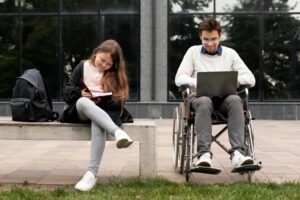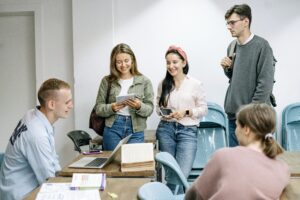Acquiring knowledge and skills in digital literacy
Materials
1. Introduction to Digital Literacy
Digital literacy is crucial for individuals with mental disabilities, as it opens up new avenues for learning, communication, and self-expression. It involves understanding how to safely and effectively navigate the digital world, which is particularly important for ensuring that people with mental disabilities can access information and services tailored to their needs. Digital literacy helps in breaking down barriers, offering adaptive learning methods, and facilitating better social connections (Bawden, 2008).
This form of literacy is not just about the technical ability to use digital devices but also about making the digital world accessible and understandable.(Margaret-Mary, Sulentic, Dowell, 2018 ) For people with mental disabilities, this could mean using specialized software that caters to their learning needs or engaging in online platforms that are designed to be more intuitive and less overwhelming.
Being digitally literate enables individuals with mental disabilities to search for information in a way that suits their learning pace and style. It also involves evaluating online content to ensure it is understandable and relevant to their needs. Furthermore, digital literacy includes learning to communicate effectively using digital tools, which can be particularly empowering for those who may find face-to-face communication challenging(Karadag, Erbaşı, Karagöz, & Özmen 2022).
Embracing digital literacy in education for people with mental disabilities can significantly enhance their autonomy, learning opportunities, and ability to connect with the world around them, making it an essential component of modern educational practices.
2. Searching for Information Online
Effective online search strategies are vital for individuals with mental disabilities, enabling them to access suitable and understandable information. Learning to use keywords effectively can dramatically improve the relevance of search results. For individuals with mental disabilities, this might mean using simpler, more direct words or phrases and relying on visual aids or voice search features to assist in formulating queries.
Understanding search engine algorithms is also beneficial. However, for those with mental disabilities, it’s more about learning how to use straightforward, clear queries and making use of tools designed to filter out irrelevant or overly complex information. Educators and caregivers can assist by introducing adaptive technologies that customize search experiences to meet individual needs (Miller, & Bartlett, 2012).
Library databases are invaluable resources, especially when they include materials tailored for people with mental disabilities, such as simplified texts, videos, and interactive learning tools. Learning how to navigate these resources can open up a world of specialized information not readily available through standard search engines.
By mastering these adapted search techniques, individuals with mental disabilities can significantly enhance their ability to find and understand information online, thereby improving their autonomy and engagement with digital content tailored to their educational needs.
3. Evaluating Digital Content
Evaluating digital content is a critical skill, especially for individuals with mental disabilities engaged in education. This process involves discerning the credibility, relevance, and accessibility of online information, which can be challenging due to the vast amount of content available. For educators and learners with mental disabilities, it’s crucial to identify digital materials that are not only factually accurate but also understandable and appropriate for the learner’s cognitive levels and learning styles.
When evaluating digital content, aspects such as clear language, straightforward layout, and the presence of supportive multimedia (like images, audio, and video) become particularly important. These features can aid comprehension and retention of information for people with mental disabilities. Additionally, checking the source’s credibility is vital; educational content should come from reputable, reliable sources, ideally with expertise in special education or mental health(Harris, 2013).
Accessibility is another key factor. Digital content should be navigable and understandable for users with various disabilities. This includes text-to-speech capabilities, alternative text for images, and easy-to-navigate interfaces. For learners with mental disabilities, these accessibility features can make the difference between a useful learning resource and one that is effectively inaccessible.
It’s also beneficial to engage with interactive content, which can provide hands-on learning experiences and immediate feedback, catering to diverse learning needs and keeping learners engaged. However, the complexity of the interaction should align with the user’s abilities and preferences.
In educational settings, teachers and caregivers should guide individuals with mental disabilities in evaluating digital content, highlighting the importance of clear, accessible, and relevant information. This guidance helps in developing critical thinking and digital literacy skills, enabling learners to become more independent and confident in navigating the digital world.
4. Digital Communication Skills
Digital communication skills are essential for everyone, including individuals with mental disabilities, as they navigate through educational environments and beyond. Effective digital communication involves understanding and adhering to netiquette—respectful and appropriate behavior online. This includes being polite, respecting others’ opinions, and avoiding digital shouting, such as using all caps in texts or emails(Shelly, Gunter, & Gunter, 2012).
For individuals with mental disabilities, learning digital communication skills must be approached with sensitivity to their specific needs. Email etiquette, for example, can be taught through clear, step-by-step instructions, emphasizing the importance of using clear subject lines, appropriate greetings, and concise messages. Visual aids, templates, and role-playing scenarios can be particularly helpful in illustrating these concepts.
Social media use requires guidance to ensure safe, respectful, and positive interactions. Educators and caregivers should emphasize the importance of privacy settings, the risks of oversharing, and the need to treat others with respect. For professional purposes, teaching individuals with mental disabilities how to present themselves appropriately online can open up new opportunities for learning and networking.
It’s also important to adapt communication methods to the individual’s abilities and comfort levels. Some may benefit from using alternative communication tools, such as speech-to-text software or visual symbols, to express themselves more effectively.
By teaching digital communication skills within the context of mental disabilities, educators can provide their students with the tools they need to interact confidently and safely in the digital world. This not only enhances their educational experience but also prepares them for broader social engagement and potential professional opportunities in the future.
5. Accessible Technology Features: Navigating Towards Inclusive Digital Horizons
Creating digital content is a powerful skill in education, particularly for individuals with mental disabilities. It involves crafting accessible, engaging materials like text, images, and videos that cater to diverse learning needs. When developing digital content for learners with mental disabilities, it’s essential to focus on clarity, simplicity, and engagement(Alexander & Levine, 2008).
Text should be presented in clear, straightforward language, avoiding jargon and complex sentences. Utilizing large, readable fonts and contrasting colors can help make the text more accessible. Additionally, breaking information into smaller, digestible chunks can aid comprehension and retention.
Images play a crucial role in enhancing understanding and maintaining interest. They should be relevant, clear, and accompanied by descriptive captions or alternative text, ensuring that learners who rely on screen readers can still access the information. Utilizing symbols or pictograms can also be beneficial, offering visual cues that support the text’s messages.
Videos offer dynamic ways to present information but should be designed with accessibility in mind. This includes using clear, slow speech; providing captions and transcripts; and ensuring that visuals are not overly busy or distracting. Videos should be short to maintain attention and segmented into topics, allowing learners to process information at their own pace.
Interactive elements, like quizzes or interactive infographics, can further enhance engagement and provide immediate feedback, helping reinforce learning in a practical, enjoyable manner. However, the design of these elements should be intuitive and straightforward to prevent frustration.
In creating digital content for education, especially for individuals with mental disabilities, the goal is to make learning materials as accessible and enjoyable as possible. By adhering to these principles, educators can create content that not only educates but also empowers learners, fostering greater independence and confidence in their digital interactions.
6. Digital Citizenship
Digital citizenship encompasses understanding and respecting the rights, responsibilities, and ethical behavior required in the digital world. For individuals with mental disabilities, education in digital citizenship is crucial to ensure they navigate online spaces safely and responsibly.
Teaching digital citizenship to people with mental disabilities involves explaining the concept in clear, simple language and using relatable examples. It’s important to cover topics such as online privacy, understanding which information is safe to share, and the importance of keeping personal details secure. Using visuals, story-based learning, and role-playing can make these concepts more understandable and relevant(Ribble, 2015).
Respectful communication is another critical aspect. This includes understanding the impact of their words online, recognizing cyberbullying, and learning appropriate ways to respond to negative interactions. Educators can use guided activities to teach students how to express themselves respectfully and deal with conflicts constructively.
Rights and responsibilities online also cover the ethical use of online resources, such as respecting copyright laws and understanding the consequences of digital piracy. Simplified explanations combined with practical examples can help individuals with mental disabilities grasp these concepts better.
Finally, promoting a positive digital footprint is essential. This involves teaching individuals how to contribute positively to online communities, engage in constructive discussions, and present themselves appropriately on social media platforms.
Educating individuals with mental disabilities on digital citizenship empowers them to participate in online communities safely and ethically, enhancing their digital literacy and social integration. It’s about providing them with the knowledge and skills to protect themselves and interact positively in the digital landscape.
7. Assessment
Assessment in digital literacy for individuals with mental disabilities should be tailored to their learning needs and abilities. A short quiz or project can effectively measure their understanding and application of digital literacy skills in a supportive and accessible manner.
For quizzes, questions should be straightforward, avoiding complex language or ambiguous terms. Multiple-choice or true/false formats can simplify decision-making. Including visual aids or interactive elements can also help individuals better understand the questions. It’s important to ensure that feedback is immediate and constructive, allowing learners to learn from their mistakes and reinforce their knowledge.
Projects offer a more hands-on approach to assessment, allowing individuals to demonstrate their digital literacy skills in a practical context. Projects could involve creating a simple digital presentation, a safe and respectful email exchange, or a basic webpage. These tasks should be clear and achievable, with step-by-step instructions and the option for personalized support.
For both quizzes and projects, it’s crucial to provide a variety of assessment methods to cater to different learning styles and abilities. Flexibility in the assessment process can help accommodate the unique needs of individuals with mental disabilities, ensuring that the evaluation is a fair reflection of their abilities and understanding.
Assessments should be seen not just as a test, but as a learning tool, contributing to the ongoing development of digital literacy. By creating an inclusive, supportive assessment environment, educators can help individuals with mental disabilities build confidence in their digital skills and encourage continuous learning and improvement(George, Areba & Ngwacho 2022).
8. Case Study
Implementing Digital Literacy for Mental Health Support. This case study highlights how digital tools and resources were effectively used to support a group of individuals with mental health challenges, leading to improved learning outcomes and social integration.
9. Conclusion
In conclusion, digital literacy is a vital skill for individuals with mental disabilities, enhancing their autonomy and ability to engage with the digital world. This unit has covered essential aspects such as effective online searching, evaluating digital content, and digital communication skills(Anderson & Rainie, 2020). By integrating these practices, we can foster a more inclusive digital environment. For further learning, refer to the provided links to additional resources and case studies.
References
Anderson, C., & Rainie, L. (2020). The Internet and Mental Health: How Online Resources Are Supporting Mental Wellness. Pew Research Center.
Bawden, D. (2008). Origins and concepts of digital literacy. In L. Lanning & A. Lloyd (Eds.), Digital literacies: Concepts, policies and practices (pp. 17-32). Peter Lang.
Bulut, Karadag., Zeynep, Erbaşı., Kazım, Karagöz., Samet, Özmen. (2022). Digital Academy for Mentally Disabled. doi: 10.56038/oprd.v1i1.152
George, Areba, Ngwacho. (2022). Utilization of Digital Technologies to Enhance Assessments, Practices, and Equity in Inclusive Education. doi: 10.4018/978-1-6684-2468-1.ch016
Miller, C. R., & Bartlett, J. (2012). Digital literacy for technical communication: 21st-century theory and practice. Routledge.
Margaret-Mary, Sulentic, Dowell. (2018). Toward a Working Definition of Digital Literacy. doi: 10.4018/978-1-5225-2255-3.CH202
Harris, R. (2013). Evaluating Internet research sources. Retrieved from http://www.virtualsalt.com/evalu8it.htm
Shelly, G. B., Gunter, G. A., & Gunter, R. E. (2012). Teachers discovering computers: Integrating technology in a connected world. Cengage Learning.
Alexander, B., & Levine, A. (2008). Web 2.0 storytelling: Emergence of a new genre. EDUCAUSE Review, 43(6), 40-56.
Ribble, M. (2015). Digital citizenship in schools: Nine elements all students should know. International Society for Technology in Education.
1. Leadership/ School’s perspective
Inclusive by Design: Advancing Digital Literacy for All
10 min
By the end of this e-learning material, participants will be able to;
- Recognize the main principles of inclusive digital education.
- Identify major inclusive digital technologies.
- Recall the role of HEI in promoting exploration of inclusive digital tools.
- Analyze the importance of fostering digital literacy in an inclusive manner.
Inclusive Digital Education, Digital Literacy, Assistive Technologies








Funded by the European Union. Views and opinions expressed are however those of the author(s) only and do not necessarily reflect those of the European Union or the European Education and Culture Executive Agency (EACEA). Neither the European Union nor EACEA can be held responsible for them (2022- 1 -SI01 -KA220-HED-000088368).






